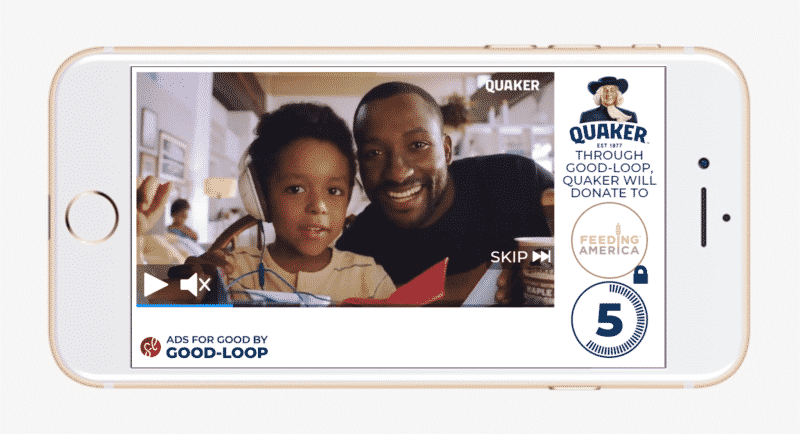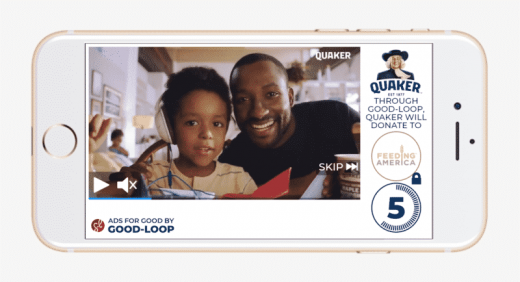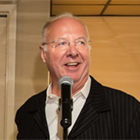Ethical advertising: How Quaker Oats helped feed America
Good-Loop’s ethical ad wrapper promoted charitable donations and an uplift in brand perception.
“Consumers have been increasingly switching from value-driven buying to values-driven buying. They’re buying based on the things they believe in and the issues they hold dear.” What’s more, advocacy, trust and loyalty are being better understood as long-term consumer metrics.
Amy Williams founded Good-Loop, a Scottish-based business, at the age of 24 to distribute ethical advertising and drive brand donations to charities selected by the consumer. Supporting the Quaker Oats “Good Starts Here” campaign, Good-Loop helped feed hunger-insecure families at scale, while fueling a 44% uplift in the perception of Quaker Oats as a brand focused on community good.
It all started at Ogilvy & Mather, where Williams had worked her way from an internship to Account Manager.
The business benefits of doing good
At Ogilvy, she became obsessed with the Unilever Sustainable Living Plan, a strategy that put social purpose and social impact at the heart of their brand image. “Let’s be honest, soap is an incredibly boring product,” she said, “but Dove is a brand that talks about Real Beauty and that’s interesting, something people can become passionate about – and that’s how Dove becomes the biggest soap brand in the world.”
The idea of helping big enterprises see the business benefits of doing good was something Williams couldn’t stop thinking about. “That was the spark that led me to found Good-Loop. Purpose often lives in beautiful, three-minute manifesto films, or rich, thought-out creative strategy slides, but it’s hard to deliver through media. Media is an under-served part of our industry when it comes to brand purpose – and public trust in advertising is at an all-time low.” Williams was determined to take what she had learned on the creative side and apply it to building media products that help brands “put their money where their mouth is” and deliver an experience that’s positive for consumers.
Good-Loop’s ethical wrapper
Consumers now tune out ads as much as possible, through ad blockers, skipping or switching tabs or channels. “There is a fundamental value exchange that has been lost. My time, my attention, my eyeballs – these are valuable; and when an advertiser forces me to watch something, that value exchange is broken.” Good-Loop works with its clients’ existing creative assets, but they deliver them in a respectful, positive manner. “We only run in skippable or opt-in formats. If you choose to opt in, if you choose to give that advertiser some of your precious time and attention, then you unlock a free donation funded by that brand. You get to do good for free in collaboration with the brand you choose to engage with it.”
The way this works is essentially simple. “Advertisers send us their video. We create our ethical wrapper, which has a countdown along the top and an interactive charity selector on the side.” If the consumer reaches the end of the countdown without skipping, they are presented with a selection of charities and Good-Loop makes the donation to the charity chosen. The ads also run across social channels with a “swipe up to donate” format.
“We deliver reports back to the client which track performance as well as brand uplift. We work with publishers to make sure that those ads get placed in really premium, brand-safe contexts. So we’re a programmatic media partner with our own unique ad format.”
Programmatic advertising sometimes has the reputation of allowing ads to show up in all kinds of inappropriate contexts, but Good-Loop exercises strict control. “We have an allow list, which we curate with the brands, and the ads only run on those sites. We manage where we buy, but we allow clients to buy us programmatically,” Williams explained.
Good-Loop doesn’t work exclusively on purpose-driven campaigns. “We worked with a beer brand recently,” said Williams. “They A/B tested two pieces of creative. One piece was product-driven, the other was championing some of their purpose initiatives. We found both did well from a performance point of view. The only real difference is that the product creative drove more purchase intent and the purpose creative drove more advocacy and loyalty.” Those long-term consumer metrics again.

Half a million meals
“Quaker Oats is a brand with so much heritage – a 140 year-old business – and their founding principle was that circumstances should never be a barrier to good nutrition,” said Williams. “From its inception, the business has been about kindness and community, and helping people eat well.”
Quaker Oats found Good-Loop when they were looking for media partners to support their new “Good Starts Here” campaign. “Unfortunately, the last eighteen months has meant that food security has been really threatened with a lot of families living below the poverty line,” Williams said. “Being able to work with Feeding America was a fantastic manifestation of Quaker Oats’ founding purpose.”
Feeding America’s mission is to provide equitable access to nutritious food for all. The creative for the campaign was “just a regular TV ad,” said Williams, “but every time you watched the ad you could unlock a donation to Feeding America.”
And the results were made publicly available in real time. “We prioritize transparent reporting on how much has actually been raised. Every campaign that we run has a live impact hub, a public-facing website.” It doesn’t just show donations numerically but also in terms of impact — in this case the meals being funded. “Through this initiative we funded half a million meals for families suffering from food insecurity,” Williams said. “A wonderful outcome.”
The post Ethical advertising: How Quaker Oats helped feed America appeared first on MarTech.
(64)



